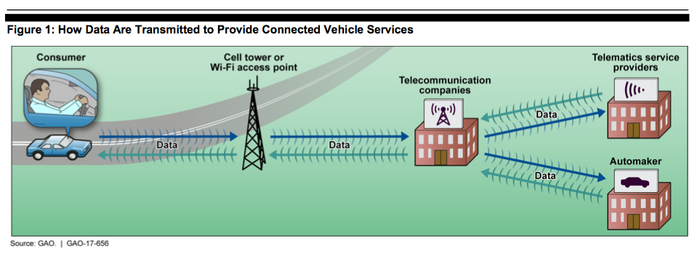Definitions[]
A connected vehicle (also called a connected car) is a vehicle that is equipped with Internet access, and usually also with a wireless local area network. This allows the car to share internet access with other devices both inside as well as outside the vehicle.
A connected vehicle is a
| “ | [v]ehicle[] that [is] connected to the Internet to offer consumer convenience and infotainment services and/or vehicles that are connected to each other (vehicle-to-vehicle) or to infrastructure (vehicle-to-infrastructure) through dedicated short-range communications.[1] | ” |
Overview[]
Connected vehicles offer services and features to consumers through wireless communication systems. Technologies, such as in-vehicle sensors and global positioning systems, generate data that are transmitted through two-way communication between a vehicle and a central computer system or a call center. As shown in figure 1, automakers use third parties to provide connectivity[2] (e.g., enable a vehicle to transmit and receive voice and data communications) and typically contract with third parties to provide support for the services offered in connected vehicles ("connected vehicle services").
For example, automakers may contract with:
- • telecommunication companies to connect a vehicle to the internet or a wireless network,
- • telematics service providers to provide connected vehicle services by staffing calling centers and processing data, and
- • content providers to provide optional applications, similar to those available on a smartphone, that consumers can access through their vehicle's console.
Connected vehicles can offer consumers a range of safety, security, and convenience services. For example, roadside assistance and automatic crash notification services allow for voice and data communication between a vehicle and a person at a call center. In providing these services, connected vehicles generate, transmit, and receive various types of data, such as a car's location.
Threats[]
The addition of Internet connectivity to infotainment consoles has already introduced threats to driver and passenger safety as a result of intercommunications between vehicle controls and entertainment. Vehicle-to-vehicle (V2V), vehicle-to-infrastructure (V2I), and vehicle-to-everything (V2X) communications introduce new attack vectors. The addition of these communication channels brings an increased threat of spoofed, manipulated, damaged, and missing sensors and actuators, which could cause vehicles to behave unpredictably.
Appropriate security measures must be taken within each subsystem as well as any communications or interactions between them. Protections must be made against user error, device malfunction, and device damage in addition to deliberate attacks by malicious actors (e.g., disgruntled employees, agents of industrial espionage, and terrorists).
Additional threats:
- Increased complexity of these dynamic networks may introduce vulnerabilities and increase exposure to potential attackers and unintentional errors.
- Set-and-forget sensors will provide ample opportunities for capture and compromise attacks to cause unexpected and unsafe behavior of vehicles.
- Threats to sensors and actuators risk harm to passengers and passersby in addition to damage to vehicles and objects on and along the road.
- Location of the vehicle could be exposed through vulnerabilities in the vehicles information system as well as those in mobile devices that may be used to interface.
- The heavy push towards automated, or "self-driving," vehicles must also be a heavy push towards fault-tolerances and fail-safes to adapt to the dynamic networks.
Source[]
- The Threats section: Interagency Report on Status of International Cybersecurity Standardization for the Internet of Things (IoT), at 38.
References[]
- ↑ Driving Change: Technology and the Future of the Automated Vehicle, at 15.
- ↑ Connectivity may be provided through a subscriber identity module—SIM—card and modem embedded in the vehicle. Connectivity may also be provided through a consumer's smartphone. In this case, the consumer's smartphone must be in the vehicle, and data are transferred or received using the consumer's cellular data plan.
Source[]
- "Overview" section: Vehicle Data Privacy: Industry and Federal Efforts Under Way but NHTSA Needs to Define Its Role, at 6-7.
See also[]
External resources[]
- U.S. Department of Transportation, Connected Vehicles (full-text).
| This page uses Creative Commons Licensed content from Wikipedia (view authors). | 
|
